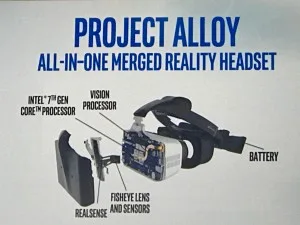Intel made a significant push into VR to kick off its CES presence in 2017. The focus was an “all-in” approach that the company took by devoting its full 45 minute press day presentation by creating a lavish 250 plush leather seat VR theater with real-time streaming of VR content to each Oculus Rift wearing journalist. (See the DisplayDaily January 10 coverage. Intel Pushes VR Boundaries at CES Press Day)
Intel made a significant investment in developing project Alloy a VR headset reference design platform for both hardware and software developers to create next generation VR technologyIn an age of flat hardware (and chip) sales, slumping demand and ‘good enough’ chromebook laptops that can deliver 80% of a contemporary PC user’s requirements, the new virtual visual experience known as VR is what every hardware manufacturer dreams of – a meaningful reason to justify a significant device upgrade.
But even that threshold is eroding, and makers can actually help VR move more firmly into the consumer space by lowering the price barrier to entry. By the end of 2016, Anshel Sag of Moorings Insight strategy notes “…the technology performance requirements for a VR-ready PC dropped from a $299 upgrade to under a $199 upgrade (Advanced Micro Devices AMD RX 480 and NVIDIA GTX 1060), and the cost of an Oculus-ready PC has now dropped to $499,” she said in her end of year blog. On the game console side, the new Sony PS4 Pro (that can power the PSVR headset) sells in the $800 range.
But remember, this is just a minimum spec, and CES is no place to minimize anything!
Case in point, on the Intel hardware side, CEO Brian M Krzanich displayed the first 10nm-powered ‘2 in 1’ PC running Intel’s next generation processor, codenamed Cannonlake as part of the CES press event. To bring the point home, the 2 in 1 played the company’s latest Jim Parsons and Michael Phelps commercial, and Intel continues to expect to ship Cannon Lake chips this year. Also on stage, Krzanich had an updated version of the VR reference design headset made by Intel labs, called Project Alloy, first shown at the Intel WWDC (short for world wide developers conference) in Q3 2016.
We’ve seen this formula replicated many times before from hardware vendors like Intel. Create a spec with a set of deliverables in a category that enables a whole new experience for the end user. Then make a hardware reference design, a proof of concept device (in this case Project Alloy) to show hardware manufacturers just how to implement, (based on Intel chips of course) and also provide software (and content) developers a platform to get their code in time for the hardware release.
The Intel spec bar is set pretty high to achieve the nirvana dubbed “merged reality.” This set of specifications was also first announced at the Intel WWDC in 2016, and includes:
- 6 Degrees of Mobility (offers real world awareness)
- Integrated Tracking with on-board sensing
- Natural manipulation (using hands to interact with virtual objects)
- Untethered (cutting the VR cord)
While some still think that VR is a solution looking for a problem, Intel is working hard to demonstrate a much broader scope of VR into a wide range of fields including travel, work and play situations to help justify the mass investments in the space. While Intel may be right, it would be wise to consider the huge expenditure in 2002 on another key driving initiative for Intel, the media center PC (remember?).
Then (as now) Intel (and Microsoft) created massive booth (s) dedicated to a new market application, in that case the media center PC, with huge bets on the PC dominating the consumer TV space. (See the WSJ article from that bygone era). Now, fast forward 15 years, and today we see a far different landscape with smartTVs dominating the CE living room space and with both MS and Intel nowhere to be seen.
That said, there is still plenty to report on VR at CES, and it’s anyone’s guess if 2017 will be the break out year that some expected 2016 to be for the VR space. So read on as we take this slice in time look at Virtual Reality at CES. Steven Sechrist

